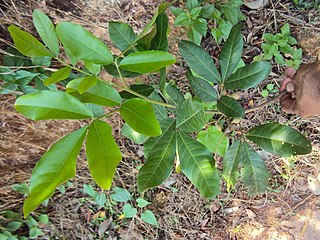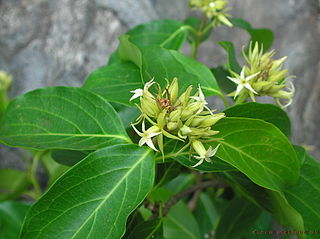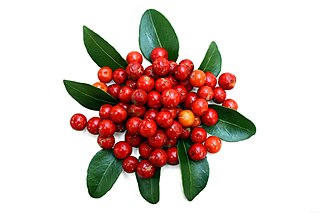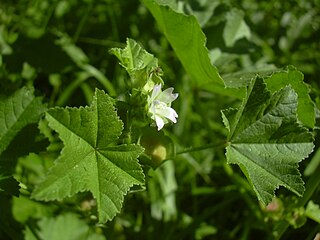
Mesua ferrea, the Sri Lankan ironwood, Indian rose chestnut, or cobra's saffron, is a species in the family Calophyllaceae. This slow-growing tree is named after the heaviness and hardness of its timber. It is widely cultivated as an ornamental due to its graceful shape, grayish-green foliage with a beautiful pink to red flush of drooping young leaves, and large, fragrant white flowers. It is native to wet, tropical parts of Sri Lanka, India, southern Nepal, Burma, Thailand, Indochina, the Philippines, Malaysia and Sumatra, where it grows in evergreen forests, especially in river valleys. In the eastern Himalayas and Western Ghats in India it grows up to altitudes of 1,500 m (4,900 ft), while in Sri Lanka up to 1,000 m (3,300 ft). It is national tree of Sri Lanka and state flower of Tripura and Mizoram.

Aphanamixis polystachya, the pithraj tree, is a species of tree in the family Meliaceae. It is native to India, Pakistan, Nepal, Bhutan, Bangladesh, Myanmar and Sri Lanka. It is a widely used as a medicinal plant in Ayurveda.

Alstonia scholaris is an evergreen tropical tree in the family Apocynaceae. It is native to southern China, tropical Asia and Australasia.

Aglaia elaeagnoidea, the droopy leaf or priyangu, is a species of plant in the family Meliaceae. It is a 10m tall tree found in American Samoa, Australia, Cambodia, India, Indonesia, Malaysia, New Caledonia, Papua New Guinea, the Philippines, Samoa, Sri Lanka, Taiwan, Thailand, Vanuatu, and Vietnam.

Cinnamomum verum, called true cinnamon tree or Ceylon cinnamon tree is a small evergreen tree belonging to the family Lauraceae, native to Sri Lanka. Among other species, its inner bark is used to make cinnamon.

Ardisia solanacea, called shoebutton ardisia in English, is a species of the genus Ardisia in family Primulaceae.

Aganosma cymosa is a liana that can grow up to 10 m (33 ft) in length, pale brownish tomentose. Leaf-stalks are 1–2 cm (0.4–0.8 in), leaf blade broadly ovate or orbicular, 5–16 cm (2.0–6.3 in) by 4–12 cm (1.6–4.7 in), base rounded or obtuse, apex acuminate or obtuse, rarely retuse, lateral veins eight to ten pairs. Flowers are borne in many-flowered clusters at branch ends, which are carried on stalks up to 6 cm (2.4 in). Bracts and bracteoles are very narrowly elliptic, about 1 cm (0.4 in) long. Flower-stalks are about 5 mm (0.2 in). Calyx with several glands inside margin of sepals; sepals very narrowly elliptic, about 1 cm (0.4 in), pubescent on both surfaces. Flowers are white, minutely tomentose outside, glabrous at throat; tube shorter than sepals, 6–7 mm (0.2–0.3 in); lobes oblong, as long as tube. Disc longer than ovary. Ovary pubescent at apex. Follicles 2, cylindric, to 30 cm (12 in) by 0.8–1.2 cm (0.3–0.5 in), yellow hirsute. Seeds oblong, 1–2 cm (0.4–0.8 in) by about 5 mm (0.2 in), coma 2–4.5 cm (0.8–1.8 in). It is native to China, Bangladesh, India, Sri Lanka, and Indochina.
Diospyros atrata, is a tree in the Ebony family. Usually may grow to 25 metres tall. The plant can be seen in subcanopy trees in medium elevation wet evergreen forests between 1000 and 1400 m in Western Ghats- South Sahyadri, Kerala, and Tamil Nadu in India and from Kandy district in Sri Lanka

Diospyros candolleana, is a tree in the Ebony family, endemic to the Western Ghats of India and Sri Lanka. The trees are usually 20m tall, and found as subcanopy trees in wet evergreen forests up to 90m.

Sterculia foetida is a soft wooded tree that can grow up to 35 metres tall. It was described in 1753 by Carl Linnaeus. Common names for the plant are the bastard poon tree, java olive tree, hazel sterculia, and wild almond tree. This is the type species of the genus Sterculia and both names mean bad-smelling: the origin of Sterculia comes from the Roman god, Sterquilinus, who was the god of fertilizer or manure.

Drypetes sepiaria is a species of small tree in the family Putranjivaceae. This tree is very common in India and Sri Lanka. It is known by many local names, including vellakasavu, veeramaram in Malayalam, vellilambu, veerai (வீரை), aadumilukkan, kaayalakkamaram in Tamil, and weera (වීර) in Sinhala.
Mallotus distans is a species of plant in the family Euphorbiaceae. It is native to South India and Sri Lanka.
Premna mollissima, the dusky fire brand mark, is an 8m high small tree in the family Lamiaceae. It is found in India, Bangladesh, and Sri Lanka.

Persea macrantha, the large-flowered bay tree, is a species of plant in the family Lauraceae. It is native to Western Ghats of India and Sri Lanka. The plant grows to about 30 m (98 ft). Leaves are simple, alternate, spiral; lamina obovate or elliptic to elliptic-oblong; apex rounded or acuminate or acute; base acute to rounded with entire margin. Flowers show terminal panicle inflorescence. Fruit is a berry where it become blackish with ripening.
Memecylon angustifolium, or blue mist, is a species of plant in the Melastomataceae family. It is native to India and Sri Lanka. Leaves are simple, opposite, decussate; lamina narrow linear-elliptic to linear-lanceolate; apex acute, base attenuate, with entire margin. Flowers are blue in color and show axillary umbels inflorescence. Fruit is a blackish purple, one-seeded berry.
Osbeckia aspera, the rough osbeckia or rough small-leaved spider flower, is a plant species in the genus Osbeckia of the family Melastomataceae. It is native to India and Sri Lanka. Leaves are elliptic-lanceolate, base attenuate with more or less velvet-hairy on both sides. Flowers are pink in color, show terminal cymes inflorescence. Fruits are single seeded capsule.

Ficus exasperata, also called the sandpaper tree, forest sandpaper fig, white fig, or sandpaper leaf tree, is a deciduous, and dioecious species of plant in the mulberry family Moraceae, native to tropical Africa, from Senegal, Ethiopia, Djibouti, Mozambique to Angola, and southern Asia of India, Sri Lanka, and to Arabian countries such as Yemen.
Eugenia mooniana, is a species of plant in the family Myrtaceae which is native to Western Ghats of India and Sri Lanka.
Ochna lanceolata is a species of plant in the family Ochnaceae. It is native to India and Sri Lanka.

Garcinia subelliptica, the happiness tree, or Fukugi tree is a species of Garcinia found in the coastal forest of Philippines, Sri Lanka, Taiwan, Indonesia (Java) and Japan
















